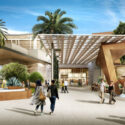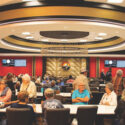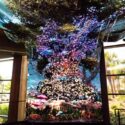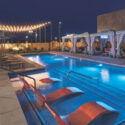The desert oasis that is Las Vegas has thrived as a resort by featuring many artificial structures-the Eiffel Tower, the New York City skyline and an Egyptian pyramid, to name a few.
But an emerging trend now taking hold in Vegas is natural landscape designs, internal and external, that add more visual serenity to the world’s most famous strip of commercial land.
“People love to be in a beautiful garden, no matter where they are,” says Julie Brinkerhoff-Jacobs of Lifescapes International Inc., which worked with Steve Wynn at the Mirage and the Wynn, and is currently in the design process at Echelon Resort. “That’s definitely one of the driving factors behind the casino gardens trend.
It’s all driven by the visitor.”
An Enlightened Outlook
With the desert as a backdrop, most landscaping in Las Vegas is developed artificially; it would never exist in such an arid environment without constant care.
“Historically, resorts took a conventional approach to landscaping, albeit within an increasingly grand and beautiful scale, and with complex site engineering challenges to match,” says Tom Donnelly, president of ValleyCrest Landscape Development. “Many attempt to evoke a theme or style that immerses the guest in either a replicated or altogether unique environment. And in some cases the landscapes are meant to complement or conceal the architecture.”
Today, Donnelly adds, “We’re seeing a more enlightened landscaping that transforms the environment, enhances the guest experience and provides a human scale to the towers that grace downtown and the Strip.”
Natural design appeal is achieved with dramatic water elements (for real and perceived cooling) and effective use of plant material (to soften harsh direct and reflected heat and light). It’s a fairly recent phenomenon in the gaming industry,” says Brinkerhoff-Jacobs.
“Until the Mirage 20 years ago,” she says, “there wasn’t a lot of attention paid to the landscape environment outside the pool area.”
The Mirage set a new trend by featuring orchids and other flora that typically would not survive in the desert. Prior to landscaping, several heat analyses had to be completed. It was a race to the finish, with major changes in landscape design implemented just six weeks before the Mirage’s grand opening.
Sheer Romance
“One of the reasons the landscape environments are so successful in Las Vegas is because we treat them all like large gardens,” says Brinkerhoff-Jacobs. “We are romanticists in garden design. We respect the geometry of the space. We are not afraid to use unusual materials to create beautiful surroundings.”
As in any industry, staying ahead of the trend curve is essential. As Las Vegas becomes an international destination-in Donnelly’s words, “a modern desert metropolis”-new natural landscapes must reflect a more modern architectural design.
“With modern building design comes the opportunity to make equally inventive statements through landscaping,” Donnelly says. “An expanded interest in drought-tolerant plant materials has led to the introduction of new species from around the world with potential applications in the Las Vegas desert. Along with an expanding plant palette, more realistic looking synthetic turf, and more sophisticated irrigation systems, landscape professionals have more tools to shift the Las Vegas paradigm.”
The “large garden” now in vogue can make other natural destinations (like pool areas) more inviting. Because pools today can be situated on up to five acres of land, resorts want to make use of them day and night.
“The pool setting and cabana design have changed,” says Brinkerhoff-Jacobs. “Now you have to figure in the restaurants, fire pit experience, and cocktail areas. We’ve completed over 20 casino properties in the Las Vegas metro area, and this is definitely a big trend.”
Another trend: interior gardens in surprising areas, like retail and other gathering spaces.
Surviving the Desert
Because the desert is subject to extremes of heat, cold and wind as well as seasonal monsoons and long periods of drought, the palette of materials available is limited.
“Our challenge is to develop a theme that evokes a specific time or place using a limited palette of locally viable materials,” says Donnelly. “The materials don’t have to be ‘native,’ but they must be able to adapt to the local climate. For the landscape contractor, the challenge is to find the right material, help it through the acclimation process, and install it in a manner that overcomes the local challenges.”
Using established local specimen trees is vital, because there is no appreciable local nursery industry in Las Vegas, and large trees from Southern California and Arizona can be expensive and difficult to transport.
“Long ago, enlightened owners recognized the value of salvaging and reusing any specimen trees on local properties,” says Donnelly. “In the preferred scenario, the trees are often on site and readily stored and transported to their new location, or they are located close enough to the site to allow for cost-effective transportation.”
The seasonal timing of planting operations is as vital as material selection. Palms are planted during the summer to avoid root rot. Pines and shrubs are planted strategically to avoid extremes of the heat and cold. Deciduous trees such as maple, birch or hickory can be planted in the middle of the winter.
“There are seasonal constraints on planting,” Donnelly says. “The challenge is to find a cost-effective approach to optimizing plant installation while coordinating with all of the other trades on site. You don’t want to throw the overall project schedule into chaos.”
When using plants from outside the area-in Vegas and elsewhere-it’s helpful to import them one or more seasons prior to installation. It allows the plants to adjust and avoids the losses that can result from dramatic climate change.
“(Imported) nursery plants may lose leaves or suffer scald, but the leaves and shoots that subsequently emerge will be adaptively structured to better tolerate their new environment,” says Donnelly. “But this process is costly, as it requires sufficient land on or near the project site and sufficient lead time prior to the installation date.”
The desert soil is hard on non-native plant material, so another required strategy is soil amendment. In soil chemistries that are more alkaline and saline, and low in organic content and cation exchange rates, percolation levels can range from slow to non-existent. To accommodate this situation, the planting process is modified with the addition of oversized planting pits, plant pit sub-drains or auger-drilled drainage pumps combined with sand-based planting soils to facilitate drainage and air-exchange on the root zone.
“For shrubs planted as a dense mass, it’s not uncommon to over-excavate the entire shrub area and place a layer of amended sand-based planter soil down,” says Donnelly.
Fertilizer treatment works hand in hand with a soil amendment regimen to produce the desired results, and fertilizer injection systems ensure plant nutrients are delivered, often through the irrigation system with a precision injection pump system. This strategy allows for general plant nutrition and long-term pH correction while reducing the effect of maintenance labor that interferes with the guest experience.
Finally, drip irrigation systems are key. The heat and wind of Las Vegas can decrease the efficiency of a conventional overhead irrigation system because water is lost to drift and evaporation.
“Drip irrigation systems have become the norm in Las Vegas as a way to conserve water through precision delivery,” says Donnelly.
Establishing a long-term strategy for maintenance is another way to reduce maintenance labor costs, reduce green waste production and limit water use with no negative impact on curb appeal.
Techno Trends
Technology has certainly made maintenance easier. Modern irrigation systems feature flow sensors and data recorders that detect unnatural water flow, causing an automatic shutdown and quick notification of maintenance personnel.
Other basic maintenance trends utilized by gaming resorts include upgrading irrigation systems to match specific plant needs, and keeping shrub areas properly mulched, preferably with a mulch made of recycled “green waste,” shredded to a uniform consistency and composted.
Mulching lawnmowers are preferred on natural turf, but Donnelly recommends removing natural turf when possible and replacing it with more drought-tolerant plant materials, including woody shrubs, perennials, cacti or succulents.
Proper pruning techniques and the selective removal of inappropriate and underperforming trees and shrubs are also necessary for basic maintenance and a successful natural landscape.
















